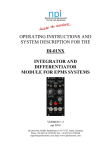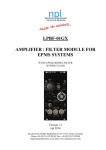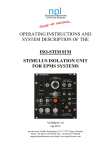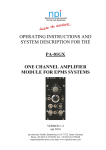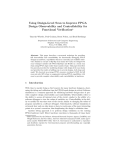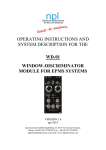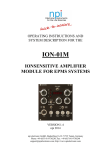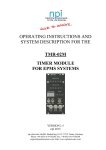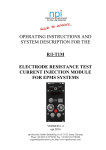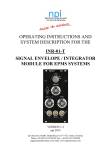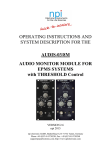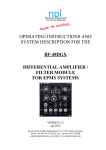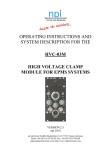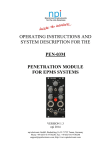Download TRC-01M - NPI Electronic Instruments
Transcript
OPERATING INSTRUCTIONS AND SYSTEM DESCRIPTION FOR THE TRC-01M TRANSIENT COMPENSATION MODULE FOR EPMS SYSTEMS VERSION 1.0 npi 2007 npi electronic GmbH, Bauhofring 16, D-71732 Tamm, Germany Phone +49 (0)7141-9730230; Fax: +49 (0)7141-9730240 [email protected]; http://www.npielectronic.com TRC-01M User Manual ________________________________________________________________________________________________________________ Table of Contents 1. Safety Regulations ............................................................................................................ 3 2. EPMS-07 Modular Plug-In System .................................................................................. 4 2.1. General System Description / Operation ..................................................................... 4 2.2. EPMS-07 Housing ....................................................................................................... 4 2.3. EPMS-E-07 Housing ................................................................................................... 4 2.4. PWR-03D .................................................................................................................... 4 2.5. System Grounding ....................................................................................................... 5 EPMS-07 ..................................................................................................................... 5 EPMS-E-07.................................................................................................................. 5 2.6. Technical Data ............................................................................................................. 5 EPMS-07 ..................................................................................................................... 5 EPMS-E-07.................................................................................................................. 5 3. TRC-01M ......................................................................................................................... 6 3.1. System Description ...................................................................................................... 6 3.2. Description of the Front Panel ..................................................................................... 6 4. Operation .......................................................................................................................... 9 4.1. Recommended connections ......................................................................................... 9 4.2. Adjusting the compensation circuit ............................................................................. 9 5. Technical Data .................................................................................................................. 10 ___________________________________________________________________________ version 1.0 page 2 TRC-01M User Manual ________________________________________________________________________________________________________________ 1. Safety Regulations VERY IMPORTANT: Instruments and components supplied by npi electronic are NOT intended for clinical use or medical purposes (e.g. for diagnosis or treatment of humans), or for any other life-supporting system. npi electronic disclaims any warranties for such purpose. Equipment supplied by npi electronic must be operated only by selected, trained and adequately instructed personnel. For details please consult the GENERAL TERMS OF DELIVERY AND CONDITIONS OF BUSINESS of npi electronic, D-71732 Tamm, Germany. 1) GENERAL: This system is designed for use in scientific laboratories and must be operated by trained staff only. General safety regulations for operating electrical devices should be followed. 2) AC MAINS CONNECTION: While working with the npi systems, always adhere to the appropriate safety measures for handling electronic devices. Before using any device please read manuals and instructions carefully. The device is to be operated only at 115/230 Volt 60/50 Hz AC. Please check for appropriate line voltage before connecting any system to mains. Always use a three-wire line cord and a mains power-plug with a protection contact connected to ground (protective earth). Before opening the cabinet, unplug the instrument. Unplug the instrument when replacing the fuse or changing line voltage. Replace fuse only with an appropriate specified type. 3) STATIC ELECTRICITY: Electronic equipment is sensitive to static discharges. Some devices such as sensor inputs are equipped with very sensitive FET amplifiers, which can be damaged by electrostatic charge and must therefore be handled with care. Electrostatic discharge can be avoided by touching a grounded metal surface when changing or adjusting sensors. Always turn power off when adding or removing modules, connecting or disconnecting sensors, headstages or other components from the instrument or 19” cabinet. 4) TEMPERATURE DRIFT / WARM-UP TIME: All analog electronic systems are sensitive to temperature changes. Therefore, all electronic instruments containing analog circuits should be used only in a warmed-up condition (i.e. after internal temperature has reached steady-state values). In most cases a warm-up period of 20-30 minutes is sufficient. 5) HANDLING: Please protect the device from moisture, heat, radiation and corrosive chemicals. ___________________________________________________________________________ version 1.0 page 3 TRC-01M User Manual ________________________________________________________________________________________________________________ 2. EPMS-07 Modular Plug-In System 2.1. General System Description / Operation The npi EPMS-07 is a modular system for processing of bioelectrical signals in electrophysiology. The system is housed in a 19” rackmount cabinet (3U) has room for up to 7 plug-in units. The plug-in units are connected to power by a bus at the rear panel. The plug-in units must be kept in position by four screws (M 2,5 x 10). The screws are important not only for mechanical stability but also for proper electrical connection to the system housing. Free area must be protected with covers. 2.2. EPMS-07 Housing The following items are shipped with the EPMS-07 housing: EPMS-07 cabinet with built-in power supply Mains cord Fuse 2 A / 1 A, slow Front covers In order to avoid induction of electromagnetic noise the power supply unit, the power switch and the fuse are located at the rear of the housing. 2.3. EPMS-E-07 Housing The following items are shipped with the EPMS-E-07 housing: EPMS-E-07 cabinet External Power supply PWR-03D Power cord (PWR-03D to EPMS-E-07) Mains chord Fuse 1.6 A / 0.8 A, slow Front covers The EPMS-E-07 housing is designed for low-noise operation, especially for extracellular and multi channel amplifiers with plugged in filters. It operates with an external power supply to minimize distortions of the signals caused by the power supply. 2.4. PWR-03D The external power supply PWR-03D is capable of driving up to 3 EPMS-E housings. Each housing is connected by a 6-pole cable from the one of the three connectors on the front panel of the PWR-03D to the rear panel of the respective EPMS-E housing. (see Figure 1, Figure 3). A POWER LED indicates that the PWR-03D is powered on (see Figure 1). Power switch, voltage selector and fuse are located at the rear panel (see Figure 2). Note: The chassis of the PWR-03D is connected to protective earth, and it provides protective earth to the EPMS-E housing if connected. ___________________________________________________________________________ version 1.0 page 4 TRC-01M User Manual ________________________________________________________________________________________________________________ Figure 1: PWR-03D front panel view Figure 2: PWR-03D rear panel view Note: This power supply is intended to be used with npi EPMS-E systems only. 2.5. System Grounding EPMS-07 The 19" cabinet is grounded by the power cable through the ground pin of the mains connector (= protective earth). In order to avoid ground loops the internal ground is isolated from the protective earth. The internal ground is used on the BNC connectors or GROUND plugs of the modules that are inserted into the EPMS-07 housing. The internal ground and mains ground (= protective earth) can be connected by a wire using the ground plugs on the rear panel of the instrument. It is not possible to predict whether measurements will be less or more noisy with the internal ground and mains ground connected. We recommend that you try both arrangements to determine the best configuration. EPMS-E-07 The 19" cabinet is connected to the CHASSIS connector at the rear panel. The CHASSIS is linked to protective earth as soon as the PWR-03D is connected. It can be connected also to the SYSTEM GROUND (SIGNAL GROUND) on the rear panel of the instrument (see Figure 3). Important:: Always adhere to the appropriate safety measures. Figure 3: Rear panel connectors of the EPMS-E-07 2.6. Technical Data 19” rackmount cabinet, for up to 7 plug-in units Dimensions: 3U high (1U=1 3/4” = 44.45 mm), 254 mm deep EPMS-07 Power supply: 115/230 V AC, 60/50 Hz, fuse 2 A / 1 A slow, 45-60 W EPMS-E-07 External power supply (for EPMS-E): Dimensions of external power supply: 115/230 V AC, 60/50 Hz, fuse 1.6/0.8 A, slow (W x D x H) 225 mm x 210 mm x 85 mm ___________________________________________________________________________ version 1.0 page 5 TRC-01M User Manual ________________________________________________________________________________________________________________ 3. TRC-01M 3.1. System Description The TRC-01M was designed as an instrument for compensating capacitive transients in voltage clamp mode which occur when the potential is stepped from a holding potential to a test potential at the beginning and the end of the voltage step. In order to do this, the voltage clamp pulse is differentiated with three adjustable time constants, T1 SLOW, T2 MEDIUM and T3 FAST, and added to a linear component to compensate for the leakage current. The adjustments are made with HIGHPASS and LOWPASS filters, and an AMPLITUDE setting for each time constant. The COMMAND INPUT can also be filtered by a LOWPASS filter. This module is normally used with a differential preamplifier, e.g. npi PA-01GX or a modified LPBF-01GX in order to subtract the signal generated by the TRC-01M from the measured current signal. This procedure reduces the capacitive current transients largely, and allows it to set the current sensitivity at the amplifier (see respective amplifier manual) to higher values without saturating the data acquisition. Therefore, the effective resolution of the recorded signal is better. Note: The voltage clamp circuit of the amplifier is not affected, i.e. the TRC-01M cannot be used to get the voltage clamp faster!! 3.2. Description of the Front Panel Figure 4: TRC-01M front panel view ___________________________________________________________________________ version 1.0 page 6 TRC-01M User Manual ________________________________________________________________________________________________________________ The front panel elements for the three time constants T1, T2 and T3 are identical and therefore described only once for T1. (1) COMMAND LOWPASS potentiometer 10-turn potentiometer for setting the time constant of the LOWPASS filter for the command voltage (range: 3,3 ms to 140 µs) (2) COMMAND AMPLITUDE potentiometer 10-turn potentiometer for setting the AMPLITUDE for the command voltage (range 0% to 100%). Using this potentiometer the AMPLITUDE of the command voltage can be attenuated in order to avoid clipping. (3) LINEAR AMPLITUDE potentiometer 10-turn potentiometer for setting the AMPLITUDE of the linear component of the current caused by command step. (4) T1 SLOW LOWPASS potentiometer, (9) T1 LOWPASS RANGE switch 10-turn potentiometer for setting the time constant of the LOWPASS filter for the SLOW time constant T1 of the transient. The RANGE of this time constant is set by switch #9. Turning the potentiometer clockwise increases the time constant. (5) T1 SLOW AMPLITUDE potentiometer, (8) T1 LOWPASS GAIN DEFAULT trim pot 10-turn potentiometer for setting the AMPLITUDE of the SLOW time constant T1 of the transient. The AMPLITUDE determines the fraction of T1 from the summed signal at connector #10. (6) T1 SLOW HIGHPASS potentiometer, (7) T1 HIGHPASS RANGE switch 10-turn potentiometer for setting the time constant of the HIGHPASS filter for the SLOW time constant T1 of the transient. The RANGE of this time constant is set by switch #7. Turning the potentiometer clockwise decreases the time constant. (10) SUMMING OUTPUT connector BNC connector providing the sum of all time constants and the linear component which will be subtracted from the recorded current signal. This signal is not inverted. (11) CURRENT HS connector BNC connector for connecting the current output from the voltage clamp amplifier. The transient generated by the TRC-01M is subtracted from this signal by the LPBF-01GX in this configuration. (11) MONITOR T1 OUTPUT connector BNC connector providing the signal obtained from differentiation of the command signal using the setting of the SLOW time constant T1. (12) MONITOR LINEAR OUTPUT connector BNC connector providing the linear component of the transient. ___________________________________________________________________________ version 1.0 page 7 TRC-01M User Manual ________________________________________________________________________________________________________________ (13) MONITOR FILTERED COMMAND connector BNC connector providing the FILTERED COMMAND signal. This signal can be linked to the VOLTAGE COMMAND INPUT of the amplifier (see amplifier manual). In this case, this signal should be monitored in parallel by an oscilloscope in order to control the right COMMAND value when using the COMMAND AMPLITUDE potentiometer (see above). (14) COMMAND INPUT connector BNC connector for connecting the voltage clamp COMMAND signal. Usually this signal is also connected to the VOLTAGE COMMAND INPUT of the amplifier. ___________________________________________________________________________ version 1.0 page 8 TRC-01M User Manual ________________________________________________________________________________________________________________ 4. Operation This TRC-01M is operated in conjunction with a slightly modified TEC-05X (no CURRENT FILTER, no CURRENT SENSITIVITY switch) and a slightly modified LPBF-01GX (see also addenda to the respective manuals). 4.1. Recommended connections Connect a command signal for the voltage clamp (e.g. from the data acquisition system) to COMMAND INPUT (#15, Figure 4) and in parallel to the VOLTAGE COMMAND INPUT of the amplifier using a branch connection. Connect CURRENT OUTPUT FROM HEADSTAGE of the amplifier to CURRENT HS (#11, Figure 4) of the TRC-01M Connect the SUMMING OUTPUT (#10, Figure 4) to an oscilloscope and/or a data acquisition system. Connect the OUT connector of the filter LPBF-01GX to an oscilloscope and a data acquisition system. If required Connect the MONITOR OUTPUTS to an oscilloscope to watch the OUTPUTS of the single time constants and the linear component. Note: In this configuration signals from the TRC-01M are linked to the LPBF-01GX using the EPMS-07 bus. 4.2. Adjusting the compensation circuit Set the amplifier to VC mode Apply a test pulse to the system which does not activate ion channels Watch OUT of the filter LPBF-01GX (both additional switches TRC/TEC in upper position). You will see the ohmic response of the cell which is compensated by the LINEAR potentiometer Watch the beginning of the voltage step of the SUMMING OUTPUT of the TRC-01M and CURRENT OUTPUT from the amplifier at an expanded time base. Shape the signal at the SUMMING OUTPUT using the three time constant settings so that it is as identical as possible with the CURRENT OUTPUT signal from the amplifier. Ideally this leads to a perfect compensation of the transient. Important: The values of the time constants generated by the TRC-01M are NOT identical with the real values of the cell membrane!! ___________________________________________________________________________ version 1.0 page 9 TRC-01M User Manual ________________________________________________________________________________________________________________ 5. Technical Data Module for EPMS-07 System COMMAND IN: Low Pass Frequency Range: Amplitude: Impedance: 300 Hz (3,3 ms) to 7 kHz (140 µs) 0 % to 100 %, i.e. 0 V to 10 V 100 k GAIN for T1, T2 and T3: x1 to x50 with trim pot GAIN DEFAULT Time constants T1 low pass range x1: range x10: range x100: 1.1 ms to 100 µs 11 ms to 1 ms 110 ms to 10 ms Time constants T1 high pass range x1: range x10: range x100: 110 ms to 10 ms 11 ms to 1 ms 1.1 ms to 100 µs Time constants T2 low pass range x1: range x10: range x100: 110 µs to 10 µs 1.1 ms to 100 µs 11 ms to 1 ms Time constants T2 high pass range x1: range x10: range x100: 11 ms to 1 ms 1.1 ms to 100 µs 110 µs to 10 µs Time constants T3 low pass range x1: range x10: range x100: 11 µs to 1 µs 110 µs to 10 µs 1.1 ms to 100 µs Time constants T3 high pass range x1: range x10: range x100: 1.1 ms to 100 µs 110 µs to 10 µs 11 µs to 1 µs Output Impedances: 249 EPMS-07 SYSTEM Power Requirements 115/230 V AC, 60/50 Hz, fuse 0.8/0.4 A, slow, 45-60 W (depending on the modules plugged in) Dimensions 19” rackmount cabinet, 3U high (1U = 1 3/4” = 44.45 mm) ___________________________________________________________________________ version 1.0 page 10










